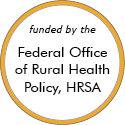Rural Project Examples: Children and youth
Other Project Examples
Wisconsin Early Education Shared Service Network
Updated/reviewed October 2022
- Need: Throughout the state of Wisconsin, childcare services are closing rapidly, with staffing and finance issues as the main causes.
- Intervention: In Wisconsin's Monroe and Vernon Counties, a collaborative that focuses on addressing key childcare access issues has come up with a creative solution. The Wisconsin Early Education Shared Services Network allows childcare providers to pool staff, resources, and services while receiving support for business and educational operations.
- Results: As of September 2022, 25 child care programs in Monroe and Vernon Counties have joined WEESSN and more are considering. Joining has allowed child care providers to focus their time, finances, and energy on the children they serve.
Butte Child Evaluation Center

Updated/reviewed August 2022
- Need: Before 2000, Butte and southwest Montana had around 1,300 cases of child abuse a year, with only a 20% conviction rate for perpetrators of sexual abuse.
- Intervention: Multiple agencies in the community came together to address the issue of child abuse by forming the Butte Child Evaluation Center (CEC), a Children's Advocacy Center.
- Results: During a 3-year grant cycle, over 200 interviews and exams were performed on victims of sexual abuse and the Butte CEC became the first program in Montana to be accredited by the National Children's Alliance.
Fostering Futures in Menominee Nation
Updated/reviewed August 2022
- Need: Since the late 1800's, trauma caused by historic events have greatly affected the way of life for Menominee Indians living on the Menominee Reservation. Economic, socioeconomic, behavioral health, and physical health issues have risen and are causing direct implications for Menominee youth.
- Intervention: Through Fostering Futures, clinic, school, and Head Start/Early Head Start staff are trained in administering trauma-informed care and building resilience among children.
- Results: Behavioral health visits at the Menominee Tribal Clinic have increased, school suspension rates have decreased, and graduation rates have improved from 60% to 94% since 2008.
North Carolina Innovative Approaches Initiative
Updated/reviewed July 2022
- Need: Children and youth with special healthcare needs (CYSHCN) face many barriers to coordinated, comprehensive, and culturally competent healthcare.
- Intervention: The North Carolina Innovative Approaches (IA) Initiative works with families of CYSHCN and other community leaders to make systems changes in the state's healthcare system.
- Results: IA has impacted 22 counties and has had a positive impact on increasing family engagement and community capacity for systems changes.
Rescue Divas EMT Recruitment
Updated/reviewed June 2022
- Need: Increased number of emergency medical technicians in rural northern Wisconsin.
- Intervention: Creation of a program, Rescue Divas, for middle school girls to spark interest in emergency medical services careers.
- Results: Post-participation results demonstrate the camp increases interest in an emergency medical services career.
Lunch Express Summer Food Program
Updated/reviewed April 2021
- Need: With school lunch programs inactive during summer months, rural children in Northeast Tennessee experienced food insecurity.
- Intervention: Second Harvest Food Bank of Northeast Tennessee used repurposed school buses to expand meal delivery to rural children in remote areas of eight counties.
- Results: During summer months, four converted school buses bring meals to nearly 350 children, traveling 11,000 miles in rural and remote areas. In toto, the organization reaches nearly 6,000 school children with food insecurity.
Club Scrub
Updated/reviewed August 2020
- Need: Rural Wisconsin communities experience threatened healthcare infrastructure due to workforce shortages.
- Intervention: The Rural Wisconsin Health Cooperative, in partnership with the Wisconsin Office of Rural Health, created a youth program to increase awareness of health-related professions known as Club Scrub.
- Results: Middle-school students attend the program and gain a better understanding of career options in the healthcare industry.
My Virtual Clinic School-Based Telehealth Program

Updated/reviewed May 2020
- Need: Improve healthcare access for school-aged children in a rural and underserved Indiana county.
- Intervention: Working with several rural school districts and the state's rural health association, an Indiana county healthcare system used school-based telehealth to expand access for acute illness.
- Results: As of May 2019, Greene County General Hospital in rural Linton, Indiana, has expanded primary care access by offering school-based telehealth in 2 elementary and 1 middle school in 3 of the county's 5 school districts.
Nelson County School Nurse Program

Updated/reviewed April 2020
- Need: Low rates of immunization and a lack of knowledge about physical health among school age children in the rural areas of Nelson County, Virginia.
- Intervention: A School Nurse Program placed a registered nurse in each of the four county public schools to track and encourage immunization compliance, provide health education, and handle students' daily health issues.
- Results: School-age children are having many of their minor health concerns addressed throughout the day by registered nurses at school. Compliance for childhood immunizations is now extremely high.
Families Plus Comprehensive Health and Mentoring for Underserved Youth

Added March 2019
- Need: Pediatric behavioral health services in Delta County, Colorado.
- Intervention: Multi-organizational and community-wide effort to increase healthcare access for underserved children and to integrate behavioral health care into the area's primary care clinics.
- Results: Sustainable increases in access to pediatric behavioral health services.
For examples from other sources, see:
